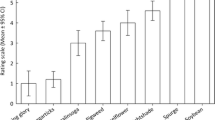Abstract
The biology and host specificity of a colony ofLixus cribricollis Boheman originating in Morocco were studied in quarantine in Australia.L. cribricollis adults are long lived, have an aestivation and are univoltine.Rumex crispus L.,Emex australis Steinheil andE. spinosa (L.)Campdera were shown to be the only satisfactory hosts of 40 species of plants from 17 families that were exposed to sexually mature adults ofL. cribricollis. Normal feeding and occasional oviposition were observed on some other plants within the same family,Polygonaceae, including the minor crops rhubarb and buckwheat, but almost invariably larvae died in the 1st instar. It was concluded thatL. cribricollis may be a useful biological control agent for the weedsR. crispus, E. australis andE. spinosa and that establishment of this weevil in Australia would be without risk to non-target plants.
Résumé
La biologie et la spécificité d'une population deLixus cribricollis Boheman provenant du Maroc ont été étudiées en quarantaine en Australie. Les adultes deL. cribricollis vivent longtemps, ils présentent une estivation et sont univoltins. On a montré queRumex cripus L.,Emex australis Steinheil etE. spinosa (L.)Compdere sont les seules plantes hôtes valables parmi les 40 espèces de 17 familles de plantes exposées à des adultes deL. cribricollis sexuellement mûrs. Une alimentation normale et une ponte occasionnelle ont été constatées sur certaines autres plantes de la même famille, lesPolygonaceae, y compris les cultures mineures que sont la rhubarbe et la renouée, mais presque invariablement les larves sont mortes au 1er stade. On en conclut queL. cribricollis peut constituer un utile agent de lutte biologique contre les mauvaises herbes,R. crispus, E. australis etE. spinosa et que l'établissement de ce charançon en Australie serait sans risque pour des plantes non visées.
Similar content being viewed by others
References
Allen, J.M. — 1974. Preliminary observations and investigations on docks (Rumex spp.) in Western Australia. —Tech. Bull. Dep. Agric. W.A. No. 23.
Hoffman, A. — 1954. Faune de France 59, Coléoptéres Curculionides. — Fédération Française des Sociétés de Sciences Naturelles, Office Central de Faunistique.Lechevalier, Paris.
Gilbey, D.J. — 1974.Emex species in Australia with particular reference to Western Australia. —J. Aust. Inst. Agric. Sci., 40, 114–120.
Julien, M.H. — 1981. A discussion of the limited establishment ofPerapion antiquum and a review of the current status of biological control ofEmex spp. in Australia. —Proc. 5th Int. Symp. Biol. Control Weeds, Brisbane, 1980, 507–514.
Julien, M.H. & Harley, K.L.S. — 1978. The initiation of biological control ofEmex spp. in Australia. —Proc. 4th Int. Symp. Biol. Control Weeds, Gainesville, 1976, 141–144.
Weiss, P.W. &Julien, M.H. — 1975. A comparison of two species of spiny emex (Emex australis andE. spinosa) in north-western Victoria. —J. Aust. Inst. Agric. Sci., 41, 211–213.
Author information
Authors and Affiliations
Rights and permissions
About this article
Cite this article
Julien, M.H., Kassulke, R.C. & Harley, K.L.S. Lixus cribricollis [Col.: Curculionidae] for biological control of the weedsEmex spp. andRumex crispus in Australia. Entomophaga 27, 439–446 (1982). https://doi.org/10.1007/BF02372067
Issue Date:
DOI: https://doi.org/10.1007/BF02372067



